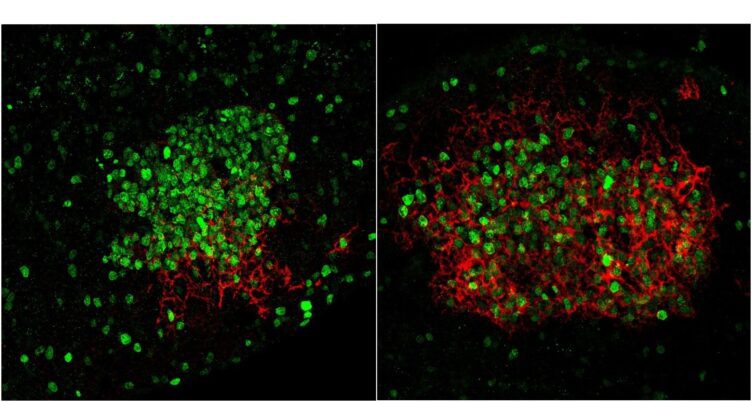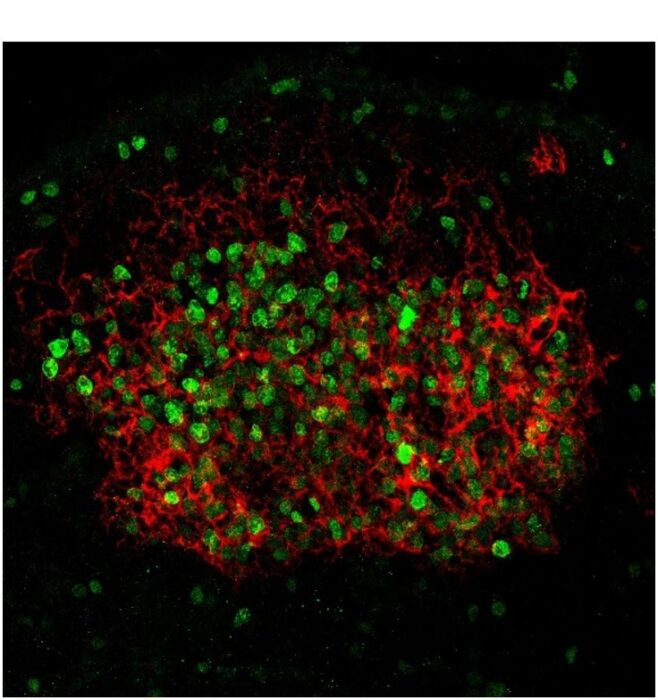This website uses cookies so that we can provide you with the best user experience possible. Cookie information is stored in your browser and performs functions such as recognising you when you return to our website and helping our team to understand which sections of the website you find most interesting and useful.
 Centro germinal con estructura normal a la izquierda y aberrante por la falta de NGFR a la derecha.
Los linfocitos B en proceso de maduración se muestran en verde, y las células que generan la estructura, en rojo. /Alberto Hernández. CNIO
Centro germinal con estructura normal a la izquierda y aberrante por la falta de NGFR a la derecha.
Los linfocitos B en proceso de maduración se muestran en verde, y las células que generan la estructura, en rojo. /Alberto Hernández. CNIO
The protein is called NGFR. CNIO researchers first discovered that blocking it reduces metastasis (in animals) and they are developing a potential drug to do just that
Now they have discovered that NGFR also has another facet: without it, the body's defence cells don’t learn to recognise the enemy and therefore fail to mount an effective immune response
The aim is to develop new therapies based on NGFR, both against cancer and to treat autoimmune diseases
Three years ago, in 2021, the Microenvironment and Metastasis Group at the Spanish National Cancer Research Centre (CNIO) discovered what could become one of the first treatments for early-stage melanoma metastasis. The researchers, led by Héctor Peinado, identified one of the key molecules responsible for preparing the ground in the part of the body where the tumour will grow, and showed in animal models that blocking it reduced metastasis.
The molecule in question is called NGFR. Over the years, they have demonstrated the effectiveness of the compound that blocks its action and proved that it is non-toxic. They are now preparing “a publication presenting the results of its use in combination with immunotherapy to treat melanoma,” says Peinado.
NGFR could also serve as a biomarker for early metastasis of melanoma, which would make it possible to anticipate the progression of the disease.
But while research is progressing in this direction, the CNIO group also wanted to understand what the NGFR molecule does in the healthy organism when there is no cancer. They have just discovered that NGFR is also key to the body’s ability to mount an effective immune response, and that it may be an important target for controlling autoimmune diseases.
This has just been published in the journal Cell Reports, in a paper with Alberto Hernández as first author.

Without NGFR, defence cells don’t ‘train’ properly
“While we were developing a therapy against metastasis, we observed that while blocking NGFR the lymph nodes appeared hypertrophied, and we decided to study this phenomenon,” explains Peinado.
Lymph nodes are an essential part of the immune system, the main site where defence cells called lymphocytes (white blood cells) are exposed to infectious agent molecules and learn to recognise them. This now published study shows that NGFR plays an important role in this process.
“B-lymphocytes are like soldiers that fire antibodies and help us fight off pathogens and infections. But to be effective, the lymphocytes need to be trained and selected in specific structures in the lymph nodes called germinal centres. When NGFR is missing, these structures are clearly abnormal and the lymphocytes do not mature properly. As a result, instead of attacking the pathogens, the lymphocytes end up attacking the organism itself,” says Hernández.
NGFR modulates the body’s immune response
The CNIO researchers have created mice that lack NGFR. These animals develop defences directed against their own healthy bodies, something that occurs in autoimmune diseases, such as lupus and Crohn’s disease.
“This tells us that NGFR regulates the effectiveness of the immune response,” explains Peinado. “By eliminating NGFR, the animal has a less effective response and that is why autoimmunity develops.”
The work contributes to the understanding of the role of this molecule as a modulator of the immune response, and establishes a link between NGFR and autoimmune diseases. It is also “a step forward in understanding the relationship between the immune system and cancer,” says Peinado.
The immune response has to do with the ability to overcome the tumour. The goal here is to “develop new therapies that modulate NGFR levels to develop an effective anti-tumour response and reduce the development of autoimmune diseases.”
The researchers believe that by striking the right balance, the NGFR blocking strategy will be more effective and enable the development of new therapies.
Reference article
Alberto Hernández-Barranco et al. NGFR regulates stromal cell activation in germinal centers. Cell Reports, 2024. https://doi.org/10.1016/j.celrep.2024.113705
